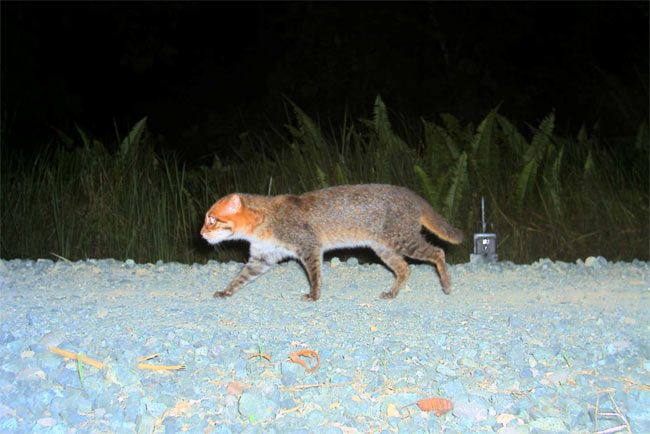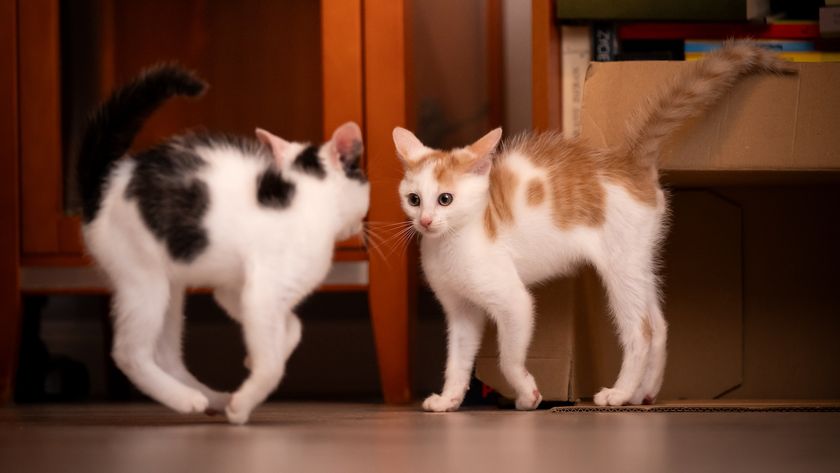Cat With Flat Head and Webbed Feet Losing Habitat

A tiny flat-headed cat with webbed feet has lost much of its historical rain-forest habitat in South-East Asia, a new study finds.
Called Prionailurus planiceps, the flat-headed cat weighs as little as 3.5 pounds (1.59 kg) and has webbed feet thought to be a unique adaptation allowing the animal to hunt fish and crabs along lowland river banks and flooded peat forests. The wild cat is one of the world's least known feline species, found only in tropical rain forests in southern Thailand, Peninsular Malaysia, parts of Indonesia including Sumatra and Borneo. In 2008 the animal was listed as an endangered species by the International Union for Conservation of Nature (IUCN).
Until now, there have been no studies of the cats in the wild, so little is known about its historical and current range, what makes a suitable home for the animal, and what can be done to ensure its survival.In fact, nobody even knows how many of the cats remain in the wild.
"At the current stage, we cannot even do any guesstimates, because we have no idea in which densities the species occurs," said study researcher Andreas Wilting of the Leibniz Institute for Zoo and Wildlife Research, Berlin, Germany. "I hope that with further field research in ten years we might be able to provide the first estimations."
To make some headway, an international team of scientists collected historical and recent records along with other scattered information on the cat, finding the animal spends its time mainly in lowland or coastal swampy forests close to freshwater sources.
"With this information we developed a computer model to predict its historical and current distribution," Wilting said.
The team also used the model to determine factors needed to make an area a sufficient home for the cat. With that information, they identified 19 key spots throughout the cat's distribution range that were considered suitable habitat and important for the long-term survival of the rare species. These localities included: Toh Daeng Peat Swamp in Thailand, the Way Kambas National Park and the Hutan Lunang Nature Reserve in Sumatra, and Borneo's Maludam National Park and the Samusam Wildlife Sanctuary.
Sign up for the Live Science daily newsletter now
Get the world’s most fascinating discoveries delivered straight to your inbox.
They found a link between freshwater sources and the occurrence of flat-headed cats, with more than 70 percent of the records (sightings and photographs) occurring less than 1.9 miles (3 kilometers) away from a major river or lake. Precipitation during the driest month and altitude were also important habitat factors.
Nearly 70 percent of the area which historically provided good habitats for the flat-headed cat has been converted into plantations, creating a landscape in which the cats are unable to live, the models showed. The remaining cat-friendly land is highly fragmented and 16 percent is fully protected according to the criteria of the IUCN.
Most large national parks in South-East Asia are located at higher elevations, where the flat-headed cat, with its restriction to lowland and coastal swampy forests, rarely occurs.
"For me the most important message of our paper is not that we predicted the extent of habitat loss, much more important is that we predicted localities where we most likely still find stable populations of this threatened species," Wilting told LiveScience. "Only with this information we can do the next step and work on the protection of these areas."
Wilting and colleagues detail their findings in a recent issue of hte journal PLoS ONE.
- House Cats' Wild Ancestor Found
- Top 10 Amazing Animal Abilities
- How Do Cats Purr?
Jeanna Bryner is managing editor of Scientific American. Previously she was editor in chief of Live Science and, prior to that, an editor at Scholastic's Science World magazine. Bryner has an English degree from Salisbury University, a master's degree in biogeochemistry and environmental sciences from the University of Maryland and a graduate science journalism degree from New York University. She has worked as a biologist in Florida, where she monitored wetlands and did field surveys for endangered species, including the gorgeous Florida Scrub Jay. She also received an ocean sciences journalism fellowship from the Woods Hole Oceanographic Institution. She is a firm believer that science is for everyone and that just about everything can be viewed through the lens of science.













